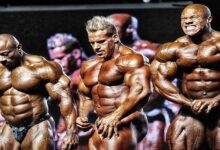The Science of Muscle Growth: Understanding Hypertrophy

Building Bigger, Stronger Muscles Through Hypertrophy
The desire to build bigger, stronger muscles is a common goal for many people who are passionate about fitness and exercise. Whether you are a professional athlete, a bodybuilder, or just someone who wants to improve your physique and overall health, the process of building muscle can be challenging, but also incredibly rewarding.
One of the key factors in building muscle is hypertrophy, a term that refers to the increase in size and strength of muscle fibers. Hypertrophy is a complex process that involves a variety of physiological factors, including muscle fiber recruitment, protein synthesis, and hormonal regulation.
In this article, we will explore the science of hypertrophy, how it works, and what you can do to optimize your muscle growth and achieve your fitness goals.
What is Hypertrophy?
Hypertrophy is the process of increasing the size and strength of muscle fibers through a combination of mechanical stress and metabolic factors. When you engage in resistance training, your muscles are exposed to physical stress that causes microscopic damage to muscle fibers.
This damage triggers a process of repair and growth, where your body replaces damaged muscle fibers with new, stronger fibers. Over time, this process of damage and repair leads to an overall increase in muscle size and strength.
There are two types of hypertrophy: myofibrillar hypertrophy and sarcoplasmic hypertrophy.
Myofibrillar hypertrophy involves an increase in the number and size of myofibrils, the protein structures within muscle fibers that are responsible for generating force and power. This type of hypertrophy is associated with gains in strength and is typically seen in athletes who engage in high-intensity, low-volume training.
Sarcoplasmic hypertrophy involves an increase in the volume of sarcoplasm, the fluid and energy stores within muscle fibers. This type of hypertrophy is associated with gains in muscle size and is typically seen in bodybuilders and other athletes who engage in high-volume, low-intensity training.
Both types of hypertrophy can occur simultaneously, and the optimal balance between them will depend on your individual goals and training program.
How Does Hypertrophy Work?
The process of hypertrophy involves a complex interplay of physiological factors that work together to promote muscle growth and repair. These factors include muscle fiber recruitment, protein synthesis, and hormonal regulation.
Muscle Fiber Recruitment:
When you engage in resistance training, your muscles are exposed to physical stress that causes muscle fibers to contract and generate force. However, not all muscle fibers are recruited during every exercise.
Your muscles are composed of different types of muscle fibers, including slow-twitch (Type I) fibers and fast-twitch (Type II) fibers. Slow-twitch fibers are smaller and generate less force but have a high capacity for endurance. Fast-twitch fibers are larger and generate more force but fatigue more quickly.
During exercise, your body recruits muscle fibers in a specific order, starting with slow-twitch fibers and progressing to fast-twitch fibers as the intensity of the exercise increases. The amount of force generated by each muscle fiber depends on its size and contractile properties, as well as the neural signals that activate it.
Protein Synthesis:
Protein synthesis is the process by which your body builds new muscle tissue in response to exercise-induced muscle damage. When muscle fibers are damaged, your body triggers a series of biochemical reactions that activate signaling pathways involved in protein synthesis.
This process involves the activation of an enzyme called mammalian target of rapamycin (mTOR), which plays a key role in regulating protein synthesis and muscle growth. mTOR is activated by a variety of signals, including mechanical stress, amino acid availability, and hormonal signaling.
Read more about canonevent
Hormonal Regulation:
Hormones play a critical role in the process of hypertrophy, as they regulate the signaling pathways involved in muscle growth and repair. One of the most important hormones involved in hypertrophy is testosterone, a hormone that is responsible for promoting muscle protein synthesis and enhancing muscle fiber recruitment.
Testosterone is produced by the testes in males and by the ovaries in females, as well as in smaller amounts by the adrenal glands in both sexes. The level of testosterone in the body is influenced by a variety of factors, including age, sex, diet, exercise, and stress.
Resistance training has been shown to increase testosterone levels in both men and women, with higher levels of testosterone associated with greater gains in muscle size and strength. However, it is important to note that the relationship between testosterone and hypertrophy is complex and multifactorial, and there is no one-size-fits-all approach to optimizing testosterone levels for muscle growth.
Other hormones involved in the process of hypertrophy include insulin-like growth factor-1 (IGF-1), which is released in response to growth hormone and promotes muscle protein synthesis, and cortisol, a stress hormone that can have a negative impact on muscle growth if levels are too high.
Read more about canonevent
Optimizing Hypertrophy:
If you are interested in building muscle through hypertrophy, there are a variety of strategies you can use to optimize your results. These strategies include:
Progressive Overload:
Progressive overload is the practice of gradually increasing the intensity, volume, or complexity of your workouts over time. By progressively overloading your muscles, you can continue to challenge them and promote muscle growth and repair.
Nutrition:
Nutrition plays a critical role in the process of hypertrophy, as it provides the building blocks necessary for muscle growth and repair. To optimize your muscle growth, you should aim to consume a diet that is high in protein, which is essential for muscle protein synthesis, as well as other key nutrients like carbohydrates and fats.
Recovery:
Recovery is an often-overlooked aspect of muscle growth, but it is essential for allowing your body to repair and grow new muscle tissue. Adequate sleep, proper hydration, and rest days are all important for optimizing recovery and promoting muscle growth.
Individualization:
The process of hypertrophy is highly individual, and there is no one-size-fits-all approach to optimizing your muscle growth. You should work with a qualified fitness professional to develop a training program that is tailored to your individual goals and needs, taking into account factors like your fitness level, age, and previous injuries or health conditions.
Hypertrophy is a complex process that involves a variety of physiological factors, including muscle fiber recruitment, protein synthesis, and hormonal regulation. By understanding the science of hypertrophy and implementing strategies like progressive overload, nutrition, recovery, and individualization, you can optimize your muscle growth and achieve your fitness goals. Whether you are a professional athlete or just someone who wants to improve your physique and overall health, the process of building muscle through hypertrophy can be challenging but also incredibly rewarding.


